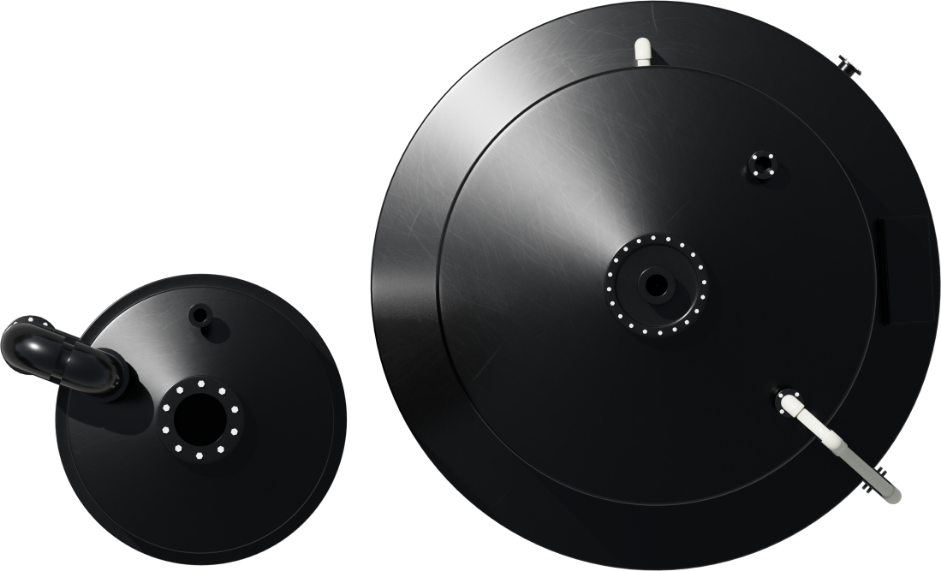Niplast has identified a real need in the market for the in-situ completion of chemical storage tanks, where the delivery of factory completed storage tanks is not possible, but the same design and quality of factory finished tanks is required.
The manufacturing processes employed by Niplast mean that factory completed and tested tank subassemblies can be transported to a customer’s site before being welded to other such subassemblies. In this state these component pieces are themselves quite flexible and they can therefore be moved carefully through narrow spaces and into the nominated location for the forthcoming SITEBILT® tank.
| Material | POLYPROPYLENE OR HIGH-DENSITY POLYETHYLENE |
The nominated area is in essence turned into a controlled and clean fabrication area for the duration of the site build process. The subassemblies are tested before leaving the Niplast factory and again upon arrival at site. Two of the main welding processes within the design code BS EN 12573 are fully transferable from factory to site, as are the in-process non-destructive testing regimes.
Niplast is then able to provide the customer with a design code compliant, fully-tested and certified chemical storage tank that could not have been installed if factory manufactured.
Examples include the replacement of hydrofluoric acid Niplast ® storage tanks 20 years old in small water treatment plants where the roof was completed following the tanks’ original installation. All components for these replacement tanks passed through a standard 2m high personnel door.
A 60,000 litre capacity polypropylene SITEBILT® tank was constructed by Niplast ® technicians for a leading UK detergents manufacturer which also incorporated a highly intricate fully draining internal conical base, pictured here.
Please watch the short animation here which demonstrates the SITEBILT ® methodology.
Site built tanks are large storage tanks constructed on location at the facility where they will be utilised. As the term indicates, site built refers to tanks assembled piece-by-piece directly on the plant grounds or foundation pad where they will reside when complete.
These tanks are custom designed to meet the required capacity, dimensions, fittings, and features for an application. Construction of site built tanks involves skilled tradespeople working in tandem to cut, weld, erect, and outfit the tank components on site. Materials like polypropylene plates or GRP structural beams are brought to the facility for fabrication. Components are joined using appropriate techniques like welding or bolting based on the materials.
Large tanks with capacities upwards of 100,000 litres are typically built on site due to transport limitations. These colossal tanks can stand around 7m tall when assembled. Site building also allows customisation if unique tank features are needed and custom maintenance procedures. Proper construction planning, safety protocols, and quality control are critical when managing the complexity of on-site tank fabrication and installation.
Site-built tanks provide complete customisable, fit-for-purpose liquid storage tailored to an operation’s specific demands. When extremely large or specialised tanks are required, on-site fabrication is often the only viable option.
Niplast has developed an innovative modular construction method for its SITEBILT® line of customisable site-built tanks. By pre-fabricating and testing major subassembly components offsite, Niplast allows for greater flexibility and control over onsite tank building.
The SITEBILT® system is made possible by Niplast’s unique manufacturing processes. Rather than construct an entire tank from raw materials onsite, Niplast produces partially pre-assembled tank sections in a controlled factory setting. Different tank parts like floors, walls, and roofs are pre-built as complete subunits.
After passing electronic spark testing, these large yet manoeuvrable subsystem components are transported to the client’s facility. The prefabricated sections can be carefully navigated through tight spaces before being welded together to form the full tank onsite.
This modular approach maximises construction efficiency. Onsite work is minimised to joining the various subunits. Since the subassemblies are pre-validated for integrity, quality assurance is enhanced. The approach allows tanks to be adapted to unique size or layout constraints by reconfiguring component orientation.
The pre-built sections feature on edge finishing to facilitate their subsequent interconnection on site. Adjacent units are linked by welding these together to create watertight seals between modules.
Niplast’s innovative SITEBILT® construction technique allows for the fast, high-quality build of custom tanks too large to transport whole. By producing tank sections in a controlled factory setting and assembling them onsite, clients get customised storage with minimal in-field fabrication required. The modular methodology streamlines site-built tanks for large-capacity storage needs.
With over 40 years of brand heritage, Niplast are experts in manufacturing plastic bulk storage tanks to strict CEN standard BS EN 12573 and its forerunner DVS 2205.
Our long history of applying these standards innovatively to solve chemical storage problems our clients meet, is what sets us apart. Sometimes you need to think outside of the tank
Today, with over 40 years of brand heritage, Niplast is an expert in manufacturing plastic bulk storage tanks or industrial tanks to strict CEN standard BS EN 12573 and its forerunner DVS 2205.
Our long history of innovatively applying these standards to solve chemical storage problems sets us apart from other brands of underground water tanks and chemical storage solutions. Sometimes, you need to think outside of the tank!
Contact Us